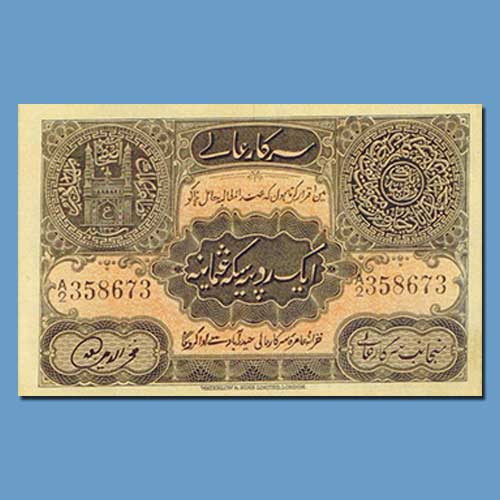One rupee Osmania Note of Hyderabad
2020-02-04 Tue
Hyderabad was a princely state in British India and was known as the ‘The Dominion of His Exalted Highness, The Nizam’. This Princely State got it right to issue metallic currency by the British Government with other thirty-four princely states.During World War I the currency situation in Hyderabad faced many difficulties. The state was unable to meet the money demand of the market due to the shortage of silver. This serious circumstance forced the government of India in 1917 to permit Hyderabad State to print its paper currency.
The above illustrated one rupee note’s text was printed in Urdu and was called Karansi Note Sarkar-e-Ali. These notes had their date in the Fasli calendar. This calendar was introduced in the Deccan region during the Mughal period and was adopted as the official calendar of the Asif Jah of Hyderabad state.
This denomination was printed on a continues sheet of watermark paper and was cut randomly. It is also interesting that the variation noticed in the watermark of this note depends upon the way paper has been cut.
Prefix A, B, and C was printed in one rupee Osmania note of Hyderabad. Yet, in circulation, the note with prefix A was released. The first issue of one rupee note signatory was Fakhruddin Ahmed.
This first one rupee note was discontinued in 1920 CE or Mir 30, 1330 AH. This note lacks popularity due to its black color. It was withdrawn from circulation in March 1939.
All the notes of Hyderabad have received unsigned form the London press. Later on, the signatures were impressed by the machine at Hyderabad mint press till 1925.
Latest News
-
Ghiyath Shah as Heir Apparent
2025-09-25 ThuGhiyath Shah was the ruler of the Malwa Sultanate, reigning from 1456 to 1500. From 1456 to 1469, he...
-
Malwa Sultan Mahmud Shah Silver Coins
2025-09-11 ThuMalwa Sultan Mahmud Shah minted silver coins in round and square flans. <br><br> For round coins,...
-
Malwa Sultan Mahmud Shah Billon coin
2025-08-26 TueMalwa Sultan Mahmud Shah's billon coins followed three weight standards: 100 rati, 96 rati, and 80 r...
-
Fascinating Archaeological Facts on Postage Stamps - 91
2025-08-23 SatRhinoceros is one of the oldest land mammal species existing in India. There are five species of rhi...
-
Fascinating Archaeological Facts on Postage Stamps - 90
2025-08-23 SatUthiramerur, a Village in Kanchipuram, Tamil Nadu, is notable for its Temple inscriptions that descr...

